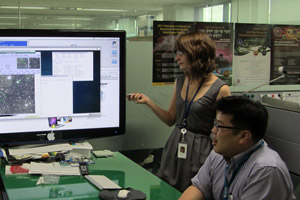 Caption: Cinthia Padilla, center, with her fellow researchers at Seoul National University. The senior physics major is analyzing data related to gravitational-wave detection at the Korean university.Download Photo
Caption: Cinthia Padilla, center, with her fellow researchers at Seoul National University. The senior physics major is analyzing data related to gravitational-wave detection at the Korean university.Download Photo
Scanning the Universe
Student Scholar Hunts for Gravitational Wave Clues During Summer in Korea
Cinthia Padilla's research in gravitational waves has taken her across several continents.
The Cal State Fullerton senior physics major is spending 10 weeks this summer at Seoul National University, where she is analyzing data related to gravitational-wave detection. In May, she traveled to Paris as part of a National Science Foundation funded-Research Experiences for Undergraduates program at University of Florida — and will return there in August to present her findings.
The Paramount resident, who first developed an interest in physics through a high school class, said she loves the experience of being in Paris and Korea.
“In Paris, I was able to see great works of art and architecture that left me in awe,” Padilla recently emailed. “And in Korea, I’ve been learning so much about their wonderful culture! It’s been great!
“My biggest surprise this summer has been that I could make it on my own and that when you set your mind to something, it can actually happen.”
“She’s really made many strides both personally and professionally,” said Josh Smith, assistant professor of physics, who has been working with Padilla.
Padilla is conducting image analysis from telescopes, comparing multiple images to look for electromagnetic 'transients' or changes, potentially related to gravitational-wave signals. Her endeavors are supported by faculty grants to Smith (a National Science Foundation award) and to Christina A. Goode, professor of chemistry and biochemistry (a Louis Stokes Alliance for Minority Participation research grant).
Gravitational waves are ripples in space and time that theoretically can be measured from Earth, said Smith, who is part of a global research effort known as the Laser Interferometer Gravitational-Wave Observatory Scientific Collaboration.
“By measuring both the gravitational wave and electromagnetic radiation, we can learn about the source. And maybe someday learn more about the Big Bang!” she explained.
When she returns to campus, Padilla will rejoin her fellow student researchers in Smith’s lab. They are:
• Graduate student Thomas Abbott of Chino, who spent part of the summer at the LIGO observatory in Livingston, LA., as part of his research in the advanced LIGO data acquisition system
• Jacqueline Lee of Aliso Viejo and senior Fabian Magana-Sandoval of Westminster, who have been measuring light scattering from refractive optics, prototypes of optics that could someday be incorporated in future detectors
• Junior Robert Wright of Brea, who has built a mini tabletop version of LIGO that he is using to measure small-length changes
• Graduate student Chris Griffo of Fullerton, like Padilla, is conducting data image analysis, comparing images to look for electromagnetic ‘transients,’ or changes related to gravitational-wave sources
Research in science, technology, engineering and mathematics, or the STEM fields, is the focus of one of the university's strategic initiatives.
July 19, 2011

